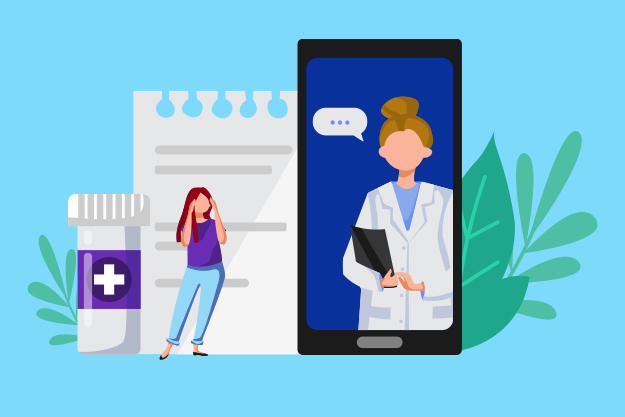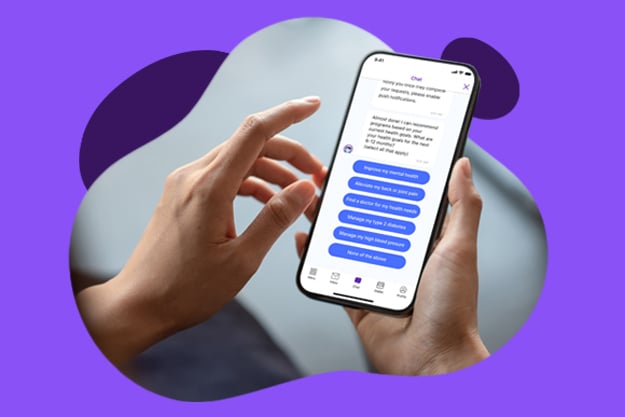Three Steps to Take Now to Ensure Benefits Success After OE
There’s a lot to consider during open enrollment, and it can be easy to focus on the new benefits you’re rolling out to employees. But taking time to...
Connected Navigation Platform
Guiding to high-value care
Behavioral Health
Foster a mentally healthy workplace
EAP
Supporting holistic wellbeing
Virtual MSK Care
Reimagining musculoskeletal care
Virtual Primary Care
Powered by smart navigation
Surgery Centers of Excellence
Best-in-class surgical outcomes
Virtual Urgent Care
Immediate care, any hour of the day
Chronic Care
A new approach to chronic care
Integrations
Flexible to any strategy

Benefits communication is notoriously tricky. Lunch and learns? Employees resent taking time out of a busy day. Long emails? They’re all too easy to ignore. Hard copies of your benefits booklet? Expect them to be quickly stuffed into a desk drawer with best intentions for review “when things slow down.”
“Everything should be made as simple as possible, but not simpler.” – Albert Einstein
You already know that good communication can make all the difference in your employees’ benefits experience. With recruiting and retention more difficult than ever, it can also drive employee engagement and help your company stand out as a great place to work. So how’s a benefits administrator supposed to cut through the noise?
Review these 7 tried-and-true strategies now to make the most of your open enrollment benefits communication.
Great communicators know the best way to introduce a new subject is to K.I.S.S: keep it simple, stupid. Think about the way Apple advertises that an iPhone has “just the right amount of everything.” Instead of leaning on technical jargon, the company relies on words like “magical” and “powerful.” Most people don’t understand, or care, about tech specs. They want a cell phone that does the things they need. In other words, they’re more interested in the benefits than the features.
Apple communicates in simple terms that even a 10-year-old can understand.
Now, ask yourself: could a 10-year-old understand most of your workplace communication? Would their eyes glaze over if you tried to explain HDHPs, co-insurance, HSA, co-payment, or HRA? Resist the urge to use the industry’s newest acronym. Remember, your employees have been snoozing through benefits presentations for years. Basic English is your safest bet for clear communication about your benefits package.
To gauge the clarity of your communications, try a tool like Hemingway Editor, which applies a reading level to your text, or use Microsoft Word’s readability tool to find out your Flesch-Kincaid readability score. These tools help you apply a measurable number to your communication strategy. Once you know the baseline, you can begin improving year over year, ensuring each open enrollment period is marked by more effective communication than the last.
Use examples to help employees understand how benefits will make their lives better. Attach an example scenario to every one of your benefits offerings. If you’re talking about telemedicine, don’t say it’s “available 24/7/365.” Point out that parents can use their new telemedicine benefit to quickly get answers when their new baby is running a fever on Thanksgiving (or, feel free to share this amazing member story with your employees!). If you’re discussing a formulary, give a tangible example of the cash price for Lipitor versus the cost on their plan. Humans relate to stories. So when they remember a relatable example, employees are more likely to think “I think I’ll one of those new employee benefits a try.”
Keeping workplace communication interesting can feel like a losing battle. After all, you’re not exactly working with the juiciest subject matter. You know that health insurance is boring. You know that deductible changes in your latest benefits plan are dry. You even know that most people would rather Britney Spears, the NBA playoffs, or their favorite new restaurant — really, truly, anything else.
But you also know the chances are good that employees will need their healthcare benefits in the next year. It’s important to reiterate that knowing what their coverage looks like now can save them money down the road. It’s just one reason a healthcare guidance platform is so critical to employee engagement and, ultimately, employee satisfaction. With turnover so high some are referring to this time period as the “great resignation,” ensuring employees get the message and see the value in their benefits is more critical than ever. Regular communication is how you get there. Offering a centralized hub for benefits navigation and communication beyond open enrollment can help bridge the gap year-round.
Read our Employee Benefits Communication Guide for more.
The ultimate goal of your benefits communication is an emotional shift from indifferent to engaged.
To achieve that goal, your internal communication must be customized to your audience’s life experiences. An open enrollment meeting for senior management won’t match one for employees on the factory floor.
Consider segmenting your communications for different email lists, focusing on the pain points that create an emotional shift for your audience. You may also need to rely on different platforms in order to communicate with different teams. If the sales team is always on the road, for example, email may not even be the answer. You may want to tell them about your new EAP benefit via text message or rely on communications broadcast through your benefits app.
Brainstorm ways to segment your audience and tweak your message. HealthJoy’s virtual assistant, JOY, will personalize messages for users on a one-on-one basis based on their habits, and can and do it at scale.
The benefits marketplace is in a state of constant change. Tools and tech are just one way to provide your employees with a simpler communication experience. It’s worth asking: is your benefits package providing the best possible self-service tools to your employees? Engagement metrics reveal a lot about the employee benefits experience, so it can be helpful to review them every year (especially ahead of open enrollment).
Calculate how much those tools are costing you for every use. Even the cheapest tools are expensive when the cost per use skyrockets due to low utilization. The key lies in building a connected experience that draws a straight line from your digital communication to the solution itself. When you can broadcast benefits communications through a single tool, then use that same tool to connect employees to healthcare navigation, virtual care, and support tools they can use year-round, employees are far more likely to actually use that tool. And your HR team is far more likely to save hundreds of hours a year.
Read our Employee Assistance Program Guide for more.
Your employees can lose interest in your communications in a matter of seconds. It’s crucial that you capture their attention and deliver your core message as quickly as possible. Yet the typical benefits booklet consists of over 200 pages of material. This information overload doesn’t stop after open enrollment ends. It’s common to see multi-page emails and other digital communication go out to employees on a monthly basis. When the brain sees too much information, it simply disengages. That’s why the “two-second rule” is an essential yardstick for clear communication.
Make sure anything you produce is scannable, with a simple hierarchy that gives priority to the most important information. It should only contain the most essential points of your message. Good communication isn’t good if employees don’t read what you share, so deliver your employee benefits communication in bite-sized pieces, rather than sending the whole meal.
You’ve heard “a picture is worth a thousand words.” So don’t forget to add graphics like on-brand images, authentic photos, animated GIFs, and beautiful fonts to your employee communications. According to Xerox, using color in communications increases attention span and recall by 82% and motivation by 80%. Need employees to respond during open enrollment? Add some color!
Another study on the “Principles of Educational Multimedia User Interface Design” showed that information presented in a visual manner results in 3X better recall than verbal. The results increased to 6X better recall if you combine visual and oral communication.
The bottom line: adding relevant graphics to your emails, going beyond text in your presentations, and even dabbling in video helps your message hit the mark.
The employee experience your HR team is building goes well beyond OE, and clear communication should, as well. Applying the principles above to employee communication throughout the year will help employees understand and use their benefits better. But because employees have so much on their plates, offering a helping hand in the form of live support and convenient self-service tools is essential as well.
In short, giving employees the information they need is not enough: to really drive employee satisfaction, your organization needs to combine good communication with the healthcare navigation support employees crave. That’s how we create healthier, happier employees.
This post was first published in 2019 and was updated in 2021.

There’s a lot to consider during open enrollment, and it can be easy to focus on the new benefits you’re rolling out to employees. But taking time to...

During the pandemic, we heard a lot about the harmful effects of delayed care. Employees who were afraid to see their doctors in person skipped...

For an employee, navigating the healthcare system is just a series of difficult decisions. With unclear pricing and confusing deductibles, it’s...